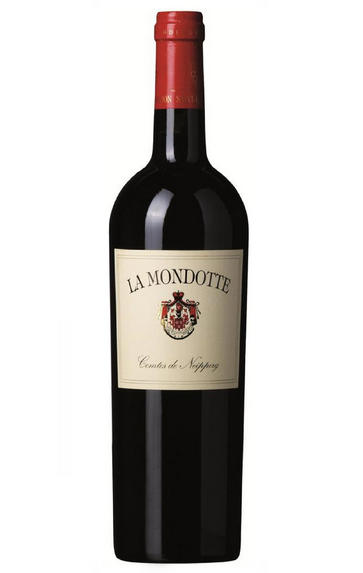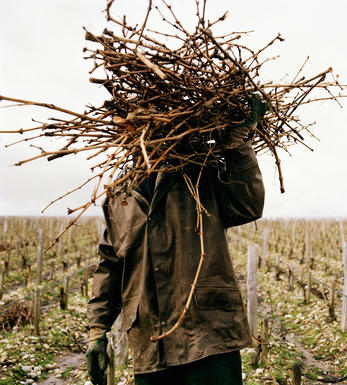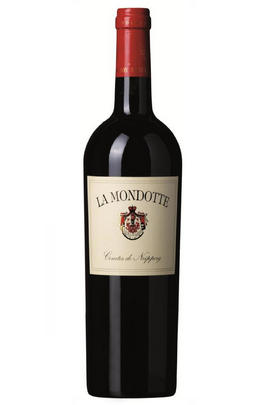
Critics reviews
Robert M. Parker, Jr. - 29/06/2015
About this WINE

La Mondotte
La Mondotte is a tiny 4.5 hectare vineyard located just east of the St-Emilion limestone plateau between Troplong-Mondot and Tertre-Rôteboeuf. It is owned by Count Stefan von Neipperg who also owns Canon-La-Gaffelière.
In the early 1990s he tried to officially merge the vineyards of Mondotte and Canon-La-Gaffelière but was thwarted in his efforts by the governing authorities on the grounds that Canon-La-Gaffelière was a St. Emilion Grand Cru Classé and Château La Mondotte was not. Incensed, he set out to prove the authorities wrong by installing a fermentation facility at La Mondotte and showing what its terroir was capable of producing.
La Mondotte's clay-rich soils and the almost perfect aspect of the steep vineyards produce super-ripe Merlot grapes and a smaller proportion of Cabernet Franc grapes. These are fermented and then matured in 100% new oak barrels for 12-18 months.
La Mondotte produces extraordinarily rich, opulent and intense and are now increasingly difficult to find.

St Émilion
St Émilion is one of Bordeaux's largest producing appellations, producing more wine than Listrac, Moulis, St Estèphe, Pauillac, St Julien and Margaux put together. St Emilion has been producing wine for longer than the Médoc but its lack of accessibility to Bordeaux's port and market-restricted exports to mainland Europe meant the region initially did not enjoy the commercial success that funded the great châteaux of the Left Bank.
St Émilion itself is the prettiest of Bordeaux's wine towns, perched on top of the steep limestone slopes upon which many of the region's finest vineyards are situated. However, more than half of the appellation's vineyards lie on the plain between the town and the Dordogne River on sandy, alluvial soils with a sprinkling of gravel.
Further diversity is added by a small, complex gravel bed to the north-east of the region on the border with Pomerol. Atypically for St Émilion, this allows Cabernet Franc and, to a lesser extent, Cabernet Sauvignon to prosper and defines the personality of the great wines such as Ch. Cheval Blanc.
In the early 1990s there was an explosion of experimentation and evolution, leading to the rise of the garagistes, producers of deeply-concentrated wines made in very small quantities and offered at high prices. The appellation is also surrounded by four satellite appellations, Montagne, Lussac, Puisseguin and St. Georges, which enjoy a family similarity but not the complexity of the best wines.
St Émilion was first officially classified in 1954, and is the most meritocratic classification system in Bordeaux, as it is regularly amended. The most recent revision of the classification was in 2012

Cabernet Sauvignon Blend
Cabernet Sauvignon lends itself particularly well in blends with Merlot. This is actually the archetypal Bordeaux blend, though in different proportions in the sub-regions and sometimes topped up with Cabernet Franc, Malbec, and Petit Verdot.
In the Médoc and Graves the percentage of Cabernet Sauvignon in the blend can range from 95% (Mouton-Rothschild) to as low as 40%. It is particularly suited to the dry, warm, free- draining, gravel-rich soils and is responsible for the redolent cassis characteristics as well as the depth of colour, tannic structure and pronounced acidity of Médoc wines. However 100% Cabernet Sauvignon wines can be slightly hollow-tasting in the middle palate and Merlot with its generous, fleshy fruit flavours acts as a perfect foil by filling in this cavity.
In St-Emilion and Pomerol, the blends are Merlot dominated as Cabernet Sauvignon can struggle to ripen there - when it is included, it adds structure and body to the wine. Sassicaia is the most famous Bordeaux blend in Italy and has spawned many imitations, whereby the blend is now firmly established in the New World and particularly in California and Australia.



Buying options
Add to wishlist
Description
From the tiny luxury jewel of the Neipperg family, the 2005 La Mondotte is composed of 80% Merlot and 20% Cabernet Franc from a fabulous terroir. Super-rich and dense purple in color, it represents a concentrated essence in both its aromatic and flavor profile of blackcurrant, black cherry, earth and spice. Full-bodied, pure, and again, possessing sweet, sweet tannin and a tremendously deep, full, layered personality. This is another great example of La Mondotte, which should drink well for 30-40 years.
Robert M. Parker, Jr. - 29/06/2015
wine at a glance
Delivery and quality guarantee